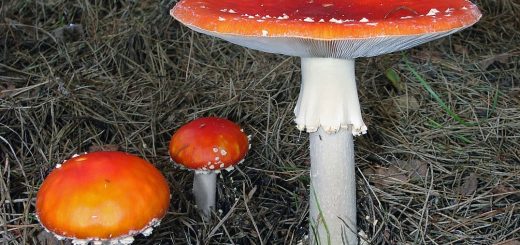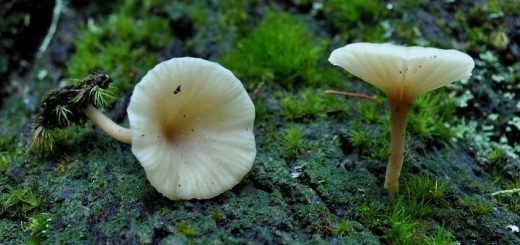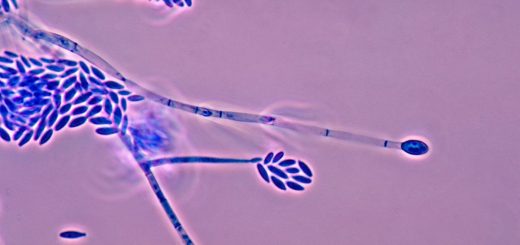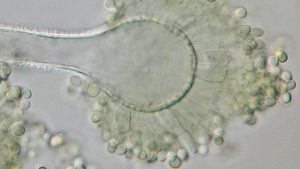#050: The Destroying Angels, Amanita virosa Species Group
NEVER EAT ANY PURE WHITE MUSHROOM. If that first sentence is as far as you read in this post, it should help you avoid ingesting the deadly poisonous mushrooms in this species group. One of the first questions you get asked when you tell someone you are interested in mushrooms is, “How can you tell whether or not a mushroom is poisonous?” Unfortunately, poisonous mushrooms come in all shapes and sizes, so you really need to learn how to avoid each of them individually. The Destroying Angels (a.k.a. Death Angels) are some of the most deadly mushrooms in the world, so every amateur mushroom hunter must be able to identify them. Luckily, they are fairly easy to recognize. Here are six things you should check for to identify a Destroying Angel:
- WHITE COLOR: The first thing you notice about these mushrooms when you see them is that they are pure white (although their flesh may yellow with age). This strikingly white color combined with the lethal toxicity is what earned these mushrooms the name Destroying Angel. These toadstools are medium-sized to large and easily draw the eye, even in the cluttered forests of summer and fall. Despite their toxicity, these are truly some of the most beautiful mushrooms in the world.
- CENTRAL STIPE: The stipe (or stalk that lifts the toadstool’s cap above the ground) is always connected to the center of the cap. The texture of the stipe ranges from somewhat shaggy to almost bald. The bottom of the stipe is usually expanded so that the base of the mushroom is bulb-like. Sometimes the base is found just below the ground, so always make sure to dig up the entire base when identifying a mushroom. The Destroying Angels are mycorrhizal (mutualistic) with the roots of nearby trees, so they are always found growing on the ground.
- FREE GILLS: The gills on the underside of the cap usually do not touch the stipe. Sometimes, however, the gills are found just barely touching the stipe.
- SKIRT-LIKE RING: The gills are covered by a thick membrane called the partial veil while they are still developing. Once mature, this membrane separates from the cap but remains connected to the stipe. In mushrooms that are fully opened, this membrane persists as a ring hanging from the stipe a little bit below the cap. The ring is thick and ends up looking somewhat like a skirt.
- SAC-LIKE VOLVA: When the mushrooms are very young, the entire fruiting body is surrounded by another membrane called the universal veil. As the cap grows and expands, it breaks through this membrane and leaves behind two types of membrane fragments. The first type is called the volva and it is found around the base of the mushroom. The volva looks somewhat like a small sac in which the toadstool’s stalk rests. Imagine a clip art picture of a newly hatched chick. The volva is equivalent to the bottom piece of the shell in which the baby bird is still standing. The universal veil can also leave pieces of tissue called warts and patches on the top of the cap. This is equivalent to the bits of eggshell dotting the clip art chick’s head. Like the eggshell pieces, warts and patches are not attached to the mushroom and can be easily brushed off. Warts and patches are usually not found on Destroying Angels, but they are common in other Amanita species.
- WHITE SPORE PRINT: Many Destroying Angel look-alikes can be separated out on the basis of spore print color. To take a spore print, cut off the cap of your fresh mushroom and place it gills-down on a piece of paper (blue paper works best)*. In a few hours, you should have a layer of spores on the paper underneath the cap. All of the Destroying Angels have a white spore print. Sometimes you can guess a mushroom’s spore print color by looking at the color of its gills. The gills of the Destroying Angles are white, just like the rest of the mushroom. However, gill color often varies with age and should not be used in lieu of the spore print. The Destroying Angels are often mistaken for the edible Agaricus campestris, which has a brown spore print.
Characteristics 2 to 6 can also be found in most other Amanita species. Many amanitas are deadly poisonous, so you should avoid eating any mushrooms with those characteristics. In short, NEVER EAT AN AMANITA. Make sure to go through this checklist for every toadstool you collect for the table. Multiple species of mushrooms are often found fruiting side by side, so you must check every one. Remember: when in doubt, throw it out!
There are actually a few different but closely related species that make up the Destroying Angels. All of them are placed in phylum Basidiomycota, class Agaricomycetes, order Agaricales, family Amanitaceae, genus Amanita, and subgenus Lepidella. Exactly how many species of Destroying Angels there are is still being researched, so most sources have varying and sometimes conflicting lists. The two most common North American Destroying Angels are Amanita bisporigera (found east of the Rocky Mountains) and A. ocreata (found west of the Rocky Mountains). Europe lays claim to the species A. virosa and A. verna, two names that were once applied to all Destroying Angels. East Asia has its own species: A. exitialis and A. subjunquillea. Wherever you are in the world, you can recognize Destroying Angels based on the checklist above. Individual species are separated out based on microscopic features and chemical reactions, so this is often not feasible or necessary for the mushroom hunter to do.
The active poisons in the Destroying Angels are from a group of toxins known as amatoxins. This family of toxins consists of small cyclopeptides that work by binding to RNA polymerase II and deactivating it. RNA polymerase II is a protein that transcribes DNA into mRNA, the first step in protein synthesis. Inhibiting RNA polymerase II prevents the cell from making new proteins, which eventually results in the cell’s death. Symptoms of amatoxin poisoning are usually not experienced until 5 to 24 hours after ingestion. This DELAYED ONSET OF SYMPTOMS can trick some people into thinking that the mushrooms they ate earlier did not cause their current symptoms. These initial symptoms are similar to food poisoning: diarrhea, nausea, vomiting, abdominal pain, etc. After a while, the person starts to feel better and often decides not to go to the hospital. The symptoms return after a day or two, but by this time too much damage has been done. Eventually, the liver and kidney shut down, causing death. If you are lucky enough to get to the hospital in time, the treatment of choice is often liver transplant. If you arrive early enough, other therapies may work to prevent this event. The death rate for victims of amatoxin poisoning is around 60%. If you want to read a first-hand account of what it’s like to eat a Destroying Angel (and survive), see the “I Survived the Destroying Angel” article at the bottom of the list below**.
* In case you were worried, you cannot get sick from touching a poisonous mushroom. You must eat it for the toxins to enter your body. Taking a spore print is absolutely safe.
See Further:
http://www.mushroomexpert.com/amanita_bisporigera.html
http://botit.botany.wisc.edu/toms_fungi/sept97.html
http://www.sierrapotomac.org/W_Needham/DestroyingAngel_100517R.htm
http://blog.mycology.cornell.edu/2006/11/28/the-destroying-angel/
** http://blog.mycology.cornell.edu/2006/11/22/i-survived-the-destroying-angel/









![#011: Characteristics of Kingdom Fungi [Archived]](https://www.fungusfactfriday.com/wp-content/themes/hueman/assets/front/img/thumb-small-empty.png)


6 Responses
[…] can look a lot like stinkhorn eggs. The difference is that Amanitas can be deadly poisonous (see FFF#050 for example). Before you eat a stinkhorn egg, cut it open to make sure that there is a mass of […]
[…] derives its name) – most notably in the Destroying Angels (Amanita virosa and relatives, see FFF#050) and in the Death Cap (Amanita phalloides, see FFF#051) – as well as in some mushrooms in the […]
[…] which are also found in such infamous species as Destroying Angels (Amanita virosa complex, FFF#050) and Death Caps (Amanita phalloides, FFF#051). In England, G. marginata goes by the beautifully […]
[…] For the next several weeks, I will examine the major groups of gilled mushrooms. I chose to start this foraging for mushrooms should learn to identify this group. In general, amanitas are umbrella-shaped agarics (FFF#027) that usually display all the following features: a universal veil, a partial veil, free gills, and a white spore print. Well-known amanitas include A. muscaria (FFF#069 and #121) as well as the Destroying Angels (FFF#050). […]
[…] a staple of Asian restaurants). V. volvacea can be easily confused with the deadly Amanita virosa (FFF#050), so always remember to thoroughly check your mushrooms before eating them. Most of the mushrooms […]
[…] which are also found in such infamous species as the Destroying Angels (Amanita virosa complex, FFF#050) and Death Caps (Amanita phalloides, FFF#051). In England, G. marginata goes by the […]